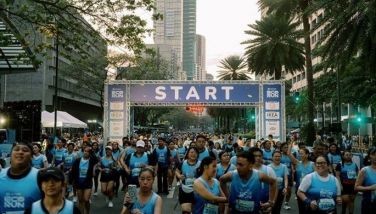And Now, Retro Running
June 4, 2006 | 12:00am
Timothy "Bud" Badyna has broken world records. He ran a marathon in under four hours. He finished a 10K race in 45 minutes.
Wait a minute, you say, that’s not so fast.
Right. But Badyna set those records running backward.
Badyna, dubbed "Backwards Bud" by fellow runners, holds the Guinness World Record for fastest backward run in a 200-meter race (32.78 seconds), set in 2001. In the early 1990s, he held the record for backward marathon (3 hours, 53 minutes) and 10K (45 minutes, 37 seconds).
Those records have since been broken. So the 39-year-old hospital nurse from St. Simon’s Island isn’t the only one who turns his back on traditional running. About 500 people in the United States–more in Europe–walk or run backward. Experts say it burns a fifth more calories than traditional jogging.
"Your balance increases. Your hearing increases. Your peripheral vision increases," said Badyna (pronounced Ba-Deena).
"The downside is being blindsided. You don’t have any eyes behind you but your senses pick up. As long as you go someplace safe– a track, a familiar road, you’ll cut down the chances of any unforseen obstacles coming your way," he said.
Backward walking and running dates back to the 1970s, when forward-looking runners practiced it while injured. Doctors later recommended it as part of physical therapy and it’s often used by baseball pitchers or track runners in preliminary warm-ups.
Also called retro-running, it’s been popular for years in Europe where races vary from sprints to the 26.2-mile marathon.
"It’s a reasonable and a good way to incorporate another means of exercise to lessen the stress on any given part of the body," said Barry T. Bates, a professor emeritus of biomechanics at the University of Oregon.
It also helps people recover from knee-joint surgery and injuries ranging from the ankle to the groin, he said.
And it strengthens the heart, lungs, muscles and joints, said Gary Gray, a physical therapist in Adrian, Mich., who has been recommending backward exercise to his patients for 30 years.
"It‘s good for the hips, good for the legs, good for the trunk," Gray said. "When you go backwards, your tummy becomes your back and creates a nice reaction for your abdominals. Putting it in reverse for a while is a pretty good deal."
The drawback, of course, is a lack of hindsight. Bates and others recommend that newcomers to backward walking or running do it gradually on a track to avoid potholes, signs, cars and other hazards.
Bill Reitemeyer of Brick, N.J., said he had trouble in his first backward race in 1993.
"I did step directly into a hole– by the grace of God, I literally pulled my foot out straight or I think I would have fallen," he said. Four years later, he won a race when two of his closest competitors tripped and fell over a bump in the road.
Running backward on roads is filled with added dangers from street gutters to parked cars.
"I used to do it on the roads, but now I stick to soccer fields," says Arthur Magni, 34, of Newton, Massachusetts, who has been running backward in competitive events for 11 years. "Start on a quiet track, somewhere there’s not a lot of people and just follow the lines."
When Badyna is training at home, he runs backward on streets while his girlfriend cycles alongside to point out any hazards. In backward races, runners often will become familiar with the course by running forward beforehand.
There is an advantage to running backward when it comes to competitions: "When you get the lead, you can see everyone, you can pace yourself better," Reitemeyer said.
"It’s strange, but you have an eye on everybody." Reitemeyer won New York City’s backwards mile race in 1995, 1997 and 1998.
Back in St. Simons Island, Badyna has his eye on regaining the world titles he lost to overseas runners. He’ll have to beat a marathon time of more than 3 hours, 43 minutes set by Xu Zhenjun of China in 2004 and a 10K time of 45 minutes, 31 seconds set by Vangal A. Mathiyazhagan of India.
"I’ve always said if someone beats that (my record) I’d try to train for that–3:43 is damn impressive," Badyna said. "I think with the right training, maybe I could do a 3:30." – AP
Wait a minute, you say, that’s not so fast.
Right. But Badyna set those records running backward.
Badyna, dubbed "Backwards Bud" by fellow runners, holds the Guinness World Record for fastest backward run in a 200-meter race (32.78 seconds), set in 2001. In the early 1990s, he held the record for backward marathon (3 hours, 53 minutes) and 10K (45 minutes, 37 seconds).
Those records have since been broken. So the 39-year-old hospital nurse from St. Simon’s Island isn’t the only one who turns his back on traditional running. About 500 people in the United States–more in Europe–walk or run backward. Experts say it burns a fifth more calories than traditional jogging.
"Your balance increases. Your hearing increases. Your peripheral vision increases," said Badyna (pronounced Ba-Deena).
"The downside is being blindsided. You don’t have any eyes behind you but your senses pick up. As long as you go someplace safe– a track, a familiar road, you’ll cut down the chances of any unforseen obstacles coming your way," he said.
Backward walking and running dates back to the 1970s, when forward-looking runners practiced it while injured. Doctors later recommended it as part of physical therapy and it’s often used by baseball pitchers or track runners in preliminary warm-ups.
Also called retro-running, it’s been popular for years in Europe where races vary from sprints to the 26.2-mile marathon.
"It’s a reasonable and a good way to incorporate another means of exercise to lessen the stress on any given part of the body," said Barry T. Bates, a professor emeritus of biomechanics at the University of Oregon.
It also helps people recover from knee-joint surgery and injuries ranging from the ankle to the groin, he said.
And it strengthens the heart, lungs, muscles and joints, said Gary Gray, a physical therapist in Adrian, Mich., who has been recommending backward exercise to his patients for 30 years.
"It‘s good for the hips, good for the legs, good for the trunk," Gray said. "When you go backwards, your tummy becomes your back and creates a nice reaction for your abdominals. Putting it in reverse for a while is a pretty good deal."
The drawback, of course, is a lack of hindsight. Bates and others recommend that newcomers to backward walking or running do it gradually on a track to avoid potholes, signs, cars and other hazards.
Bill Reitemeyer of Brick, N.J., said he had trouble in his first backward race in 1993.
"I did step directly into a hole– by the grace of God, I literally pulled my foot out straight or I think I would have fallen," he said. Four years later, he won a race when two of his closest competitors tripped and fell over a bump in the road.
Running backward on roads is filled with added dangers from street gutters to parked cars.
"I used to do it on the roads, but now I stick to soccer fields," says Arthur Magni, 34, of Newton, Massachusetts, who has been running backward in competitive events for 11 years. "Start on a quiet track, somewhere there’s not a lot of people and just follow the lines."
When Badyna is training at home, he runs backward on streets while his girlfriend cycles alongside to point out any hazards. In backward races, runners often will become familiar with the course by running forward beforehand.
There is an advantage to running backward when it comes to competitions: "When you get the lead, you can see everyone, you can pace yourself better," Reitemeyer said.
"It’s strange, but you have an eye on everybody." Reitemeyer won New York City’s backwards mile race in 1995, 1997 and 1998.
Back in St. Simons Island, Badyna has his eye on regaining the world titles he lost to overseas runners. He’ll have to beat a marathon time of more than 3 hours, 43 minutes set by Xu Zhenjun of China in 2004 and a 10K time of 45 minutes, 31 seconds set by Vangal A. Mathiyazhagan of India.
"I’ve always said if someone beats that (my record) I’d try to train for that–3:43 is damn impressive," Badyna said. "I think with the right training, maybe I could do a 3:30." – AP
BrandSpace Articles
<
>
- Latest
- Trending
Trending
Latest
Trending
Latest
Recommended















